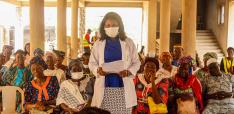Is New Power Enough in Cases Where Legislative Change is Still Needed? The Case of Russian Pro-Choice Activism and its ‘New’ Challenge to Reproductive Violence

This is the third of a four-part Global Policy blog series that seeks to spark new ways of thinking about digitally-mediated activism. It engages Timms and Heimans’ New/Old Power framework as a pivot upon which to interrogate power: asking how activists can use the internet to achieve and challenge new forms of power and ultimately, better make change happen. Read the first here.
Following last week’s blog, this post applies a more critical lens to Timms and Heimans’ New/ Old power framework by questioning the ability of ‘New’ models and values to really ‘make change happen’. It does so by looking at a very different context to that explored last week: Russian pro-choice activism under Putin’s anti-democratic regime. Despite the parallels with Flint - specifically, the use of New Power-esque social media tools to challenge Old Power’s epistemic violence - I suggest that, in authoritarian contexts such as this, the potential of New Power remains resolutely limited. While Timms and Heimans’ framework might allow us to better understand a shifting landscape of Russian activism, therefore, in the end, the neo-Bolshevik revolution at least will not be tweeted.
Background: The context for Russian pro-choice activism
Before anything else, we have to first understand the contextual barriers that this episode of Russian activism sought to confront.
This begins with the anti-democratic politics wielded by Putin himself. Whether formally or informally (in the short time that constitutional requirements forced him to step down as President, replaced by close ally Medvedev 2008-2012), Putin has for four decades remained Russia’s unchallenged leader. His attitude to dissenting voices continues to define Russia’s political landscape. Driven by a so-called ‘politics of eternity’ seeking to consolidate his ever-strengthening power, under Putin, political fact and fiction remain blurred. This allows any voice seeking to challenge his power to be quickly crushed. The killings of journalist Anna Politkovskaya in 2006 and opposition leader Boris Nemtsov in 2015; the 2020 revision of Russia’s constitution to allow Putin to serve until 2036; the recent sentencing of Alexei Navalny… take your pick - despite an appearance of democratic legitimacy, the silencing of unwanted voices remains clear.
However, overlain onto this more general context, is the specific silencing of women’s voices. Despite Russia’s historic pioneering of gender equality (introducing paid maternity leave and free workplace childcare under the 1936 Constitution, and granting the right to vote to men and women equally in the run-up to the 1917 October Revolution) Putin’s contemporary ‘War on Women’ is well-documented as facilitating a rise in domestic misogyny. Fuelled by Putin’s own hyper-masculine cult of personality (joking that Russia’s prostitutes are the best in the world, for example) recent years have seen this formalised in the legal realm - specifically, via the 2017 decriminalisation of domestic violence. An extension of Russia’s “conservative turn” spearheaded by former state Duma deputy Elena Mizulina, this continues to reflect a clear stance against Russian women’s protection in a country where estimates suggest domestic abuse kills a woman every 40 minutes.
Most recently, however, this legal violence has become manifested in clear moves to limit Russian women’s reproductive sovereignty - specifically, by limiting their freedom with regards to abortion. This takes place within an overarching context of demographic anxiety noted both in Russia and beyond, which positions women as the ‘critical threshold’ for population survival and thus justifies exceptional intervention in the name of that population. In Russia, this has been witnessed in a series of reforms over the last decade, including: a mandatory ‘week of silence’ imposed in 2011 for all women seeking abortions to re-contemplate their decisions; the 2016 Ministry of Health recommendation that all women be shown a live ultrasound of their to-be-aborted foetus; and the 2020 moratorium proposed on abortions during the Covid-19 pandemic. While not uniquely Russian - consider, for example, the US and European attempts to restrict abortions during the pandemic - this presents yet another challenge to Russian pro-choice voices.
Russian pro-choice activism and what it means for New/Old Power
In this tripartite context, rising Russian pro-choice activism arguably heralded something entirely ‘New’.
Responding originally to an onslaught of proposed abortion law reforms by Russian legislators in the spring of 2011 - including the afore-mentioned ‘week of silence’ - this initially took the form of an online campaign calling on the Russian state to ‘Fight Abortion, Not Women’. Later, in 2015, this same campaign re-emerged, responding to a new round of proposals with this same slogan, and additionally calling for ‘the right to abortion’ via a surge of social media posts across Facebook, YouTube and Instagram (Youtube channel here for individual testimonies).
Importantly, this campaign embodied both New Power’s models and values. As a joint coalition of grassroots feminists, working with the nongovernmental Russian Association of Population and Development (RAPD), it explicitly emphasised collaboration and informal networked governance: remaining fundamentally peer-driven and participatory. Of course, it also emerged largely via digital tools - recognised in our first blog as New Power’s critical enabler.
A defence of New Power?
Yet what this movement really tells us about the change-making potential of ‘New’ forms of organising remains subject to debate.
On the one hand, it formed an entirely ‘New’ challenge to the misogyny increasingly entrenched in the corridors of ‘Old’ power under Putin: reflecting, as Rivkin-Fish (2018) describes, an unprecedented Russian feminist will to assert political claims in the reproductive sphere. This reclamation of digital space is particularly significant in a context where both analogue space and social media have typically been used to lambast victims of rape and forced abortion (see, for example, this Russian Burger King advert, posted on Russian social media platform Vkontakte. It parodies a phrase used by 17 year-old rape victim Diana Shurygina on a talk show to describe how much vodka she had before being raped (‘nemnogo’ – not much, or only a little) to express that their special offer – buy one, get one free – won’t last long. The ad was eventually taken down, with no public statement or apology offered.)
On a more intrinsic level, these online forums also created new ‘claimed spaces’ for talking and healing: mounting a challenge not only to ‘Old Power’ as witnessed publicly on social media, but also as internalised within individual reproductive bodies with an ingrained cultural fear of speaking out. Seen through the lens of VeneKlasen and Miller’s ‘expressions of power’ framework, telling personal stories as part of this campaign therefore functioned to both build its collective power - ‘power with’ - and symbolised a form of therapeutic protest - building ‘power within’.
Finally, as Rivkin-Fish (2018) has also explored in detail, this episode of ‘New’ activism also allowed a fundamentally new feminism to be articulated. Diverging from liberal-oriented feminist notions of personal autonomy (upon which the Western pro-choice movement has been predominantly based) this movement’s cultural legitimacy instead drew from combining these ideas with socialist-inspired notions of state support for the childbearing process. The ‘right to abortion’ in this instance was therefore not just about the right to an individual’s choice, but also about the state’s own responsibility to provide the conditions necessary for childbearing as a social contribution - including abortion access. Extending the former blog’s conclusions, ‘New’ peer-driven forms of organising thus formed a reclamation not only of the material violence mounted by the ‘Old’ power of the Russian state, but also of the epistemic dominance of a predominantly Western feminism.
Ultimately, therefore, the ‘New/ Old’ power framework in Russia’s authoritarian context for activism offers us three things.
- First, it helps us to understand a shifting landscape for activism, how it is being reflected in ‘New’ modes of organising in authoritarian contexts such as Putin’s Russia, and how these may successfully challenge ‘Old’ misogyny.
- Second, it introduces new metrics of success that look beyond the tangible ‘so what’ of activism to instead consider participation and finding one’s voice as valued objectives in themselves - and ones which may ultimately contribute to the more sustainable overthrow of ‘Old’ power’s violences.
- Third, it allows us to better understand how local adaptations of global movements may emerge.
Or false promises?
Yet inevitably, we must return to the question asked at the end of the previous blog: how does New Power really ‘make change happen’?
On the one hand, as outlined above, digitally-mediated New Power promises Russian women the space to share their collective experiences and demand the ‘right to abortion’. Yet on the other, reality remains unchanged: while protests do exist against Russian womens’ reproductive silencing, state-sanctioned pro-life protests prevail, and an anti-abortion culture persists. The pro-choice movement, while matured, does little to threaten it.
Considering this, I argue that in authoritarian contexts such as this, the potential of New Power remains resolutely limited. While in Flint (where democracy rules) there arguably remains a possibility for digitally-mediated activism to call politicians successfully to account, in Russia (where authoritarianism rules), access to the ‘invited spaces’ of Old Power is essential to ‘making change happen’. Without the opportunity and willingness to combine New Power with Old, minimal progress will be made. This echoes recent explorations of Russian policy reform, which emphasise the importance of NGOs’ connections with government officials in their ability to act as agentic ‘policy entrepreneurs’ in the reform process. It is this connection to Old Power that enables NGOs here to promote major reforms to existing government policy, even within the constraints of Russia’s electoral authoritarian regime - and this, I argue, remains the key lesson of the case study.
Conclusion
This blog therefore ends on a somewhat sobering conclusion. Despite our enthusiasm for digitally-mediated New Power and the agentic potential it offers, while Putin’s government continues to disregard the public voice - seeing it as a factor in decision-making, but not a real force to be reckoned with - access to invited spaces will remain critical to future progress. Fundamentally, where the law is used to silence particular (female) bodies and particular (pro-choice) voices, the only way forward is to fight fire with fire: bringing Old Power back in.
Charlie Batchelor is a Freelance Research and Policy Consultant. He received his Masters in International Development and Humanitarian Emergencies with Distinction from the London School of Economics and Political Science (LSE). For business enquiries: cjd.batchelor@gmail.com. He can also be followed on Twitter: @charliejbatch
Having finished her academic pursuits for now (Geography BA from Cambridge; Development Studies MSc with Distinction from the LSE), Nina is now working as a junior public sector consultant at PricewaterhouseCoopers. So far, she has worked on issues of local government reform but hopes to expand this to gain experience working with central government and international actors in the coming months. To get in touch, contact her via LinkedIn or follow on Twitter (@NewhouseNina).
Photo by Алексей Васильев from Pexels


